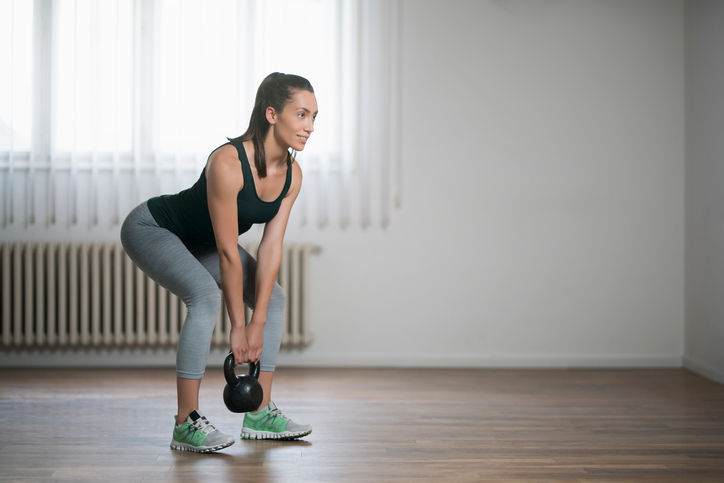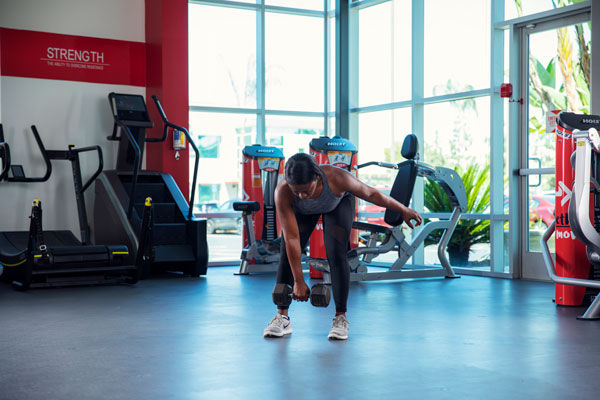You may have a favorite food, but no matter how much you love a particular flavor, you have to admit that, after a while, you want something different. Your muscles are the same way. Yes, they may respond to a particular exercise stimulus, but over time it becomes necessary to change the exercise or how it is applied so your muscles keep experiencing desired changes.
The deadlift may sound intimidating, but it is an exercise that should be the cornerstone of any strength-training program. Importantly, a deadlift is NOT a squat. To learn about the benefits of performing a deadlift along with proper lifting mechanics, check out How-to Deadlift article we created as part of the ACE Technique Series. The Romanian Deadlift is variation that specifically strengthens the hip extensors and spinal stabilizers (also addressed in a previous Technique Series article). As great as the deadlift may be, however, it can become a little stale after a while and it may be necessary to impose a different demand upon your body. The purpose of this post is to introduce a few variations of the deadlift that can be used to “spice up” the ways you engage and strengthen hip and core muscles.
Deadlift With Offset Feet
This blog about movement matrices explains the benefits of performing an exercise that is adjusted in each of the sagittal, frontal and transverse planes. Making minor adjustments to foot or hand position can create different challenges to help enhance overall strength. One variation of the standard barbell deadlift is to move the feet in different positions in the sagittal plane by performing some repetitions with the right foot forward and others with the left foot forward. As we go about our daily activities, we do not have the time to place our feet in a perfectly parallel, symmetrical position (as we would if we were performing a traditional deadlift) before picking up an object from the ground. Changing foot position for the deadlift can condition your hips to become stronger by generating force from a variety of positions.

Technique: Perform a Romanian deadlift, but keep your right foot farther forward so that the heel is even with the ball of your left foot (your specific hip mobility will determine how far apart your feet can be). After a few reps, adjust the position so that your left foot is a little farther forward. Perform the same number of repetitions for each foot position.
Dynamic Deadlift
The traditional way to do a deadlift is to address the bar from a static, non-moving position with both feet firmly planted on the ground before attempting to lift the weight. This method is great in the weight room where the focus is on lifting up a weight and setting it right back down. In real life, however, we typically pick up something to carry it somewhere or we do it from a position where we only have a couple of seconds to prepare to lift an object off the ground.
The purpose of this variation is to develop the ability to quickly step forward and pick up a heavy object from a stationary position. Note: When first performing this version, use a lighter-than-normal weight to develop the technique before increasing to a load required to enhance strength.

Technique: Place a barbell on the floor and step back three or four meters. Walk forward, quickly plant your feet approximately hip-width apart so that your shins almost touching the bar and sink back into your hips while keeping a straight spine. Use a double palms-down grip to squeeze the bar in your hands, press your feet into the floor and push your hips forward as you pull the bar up toward your hips while moving to the standing position. Finish in a tall position with your shoulders pulled back and legs straight. Return to the starting (lowered) position by shifting your weight back into your hips as you maintain a straight spine, while allowing your knees to bend to return the weight to floor. Once the weight is on the floor, take a few steps back to the starting position and repeat for the desired number of repetitions.
This variation can be combined with the first so that every time you step to the bar you have a different foot forward. This is a great option for new parents who will be performing this movement pattern frequently as they pick up their baby from a crib or a play pen.
Kettlebell (or Vertical Dumbbell) Deadlift
Traditional deadlifts are usually performed with a barbell. However, a number of people might not have access to a barbell or, because the weight of an unloaded Olympic bar is 45 pounds, the strength to use even an unloaded bar. These limitations should NOT impede the ability to use the deadlift as a means for improving the strength of the core and lower-body muscles.

Technique: If a barbell is not available or is too heavy, use either a kettlebell or dumbbell in a vertical position. Stand facing the kettlebell so that it is directly in front of you. Place your feet shoulder-width apart, maintaining a slight bend in your knees. Hinge forward at the hips, keeping your spine straight as you push your hips directly behind you. Grip the center of the kettlebell handle with both hands in a palms-down grip and squeeze the handle in both hands to maintain a firm grip. To lift the kettlebell, push your feet into the floor and press your hips forward while pulling your knees back (to engage your hamstrings and adductors). Note: The strength to move the weight should come from your legs and hips, NOT your shoulders. Come up to a tall, standing position with the kettlebell resting on the fronts of your thighs at approximately waist height. Keep your spine long as you hinge forward to perform each repetition and generate the force to lift the kettlebell by moving the hips forward to engage the glutes. Repeat for time or desired number of repetitions.
To use a dumbbell, place it in a vertical position, grab each side of the top of the weight and repeat the steps above.
One-arm Dumbbell Deadlift
Using a single dumbbell can create a unique challenge. Lifting a single dumbbell off the floor wih one hand challenges your hip and core muscles to work harder to maintain full-body stability due to the unbalanced load.


Technique: The dumbbell should be resting on the floor directly in front of you, but turned at a slight angle (if using your right hand, the dumbbell should be angled so the left end is a little farther forward and the right end back, closer to your right foot). Place your feet shoulder-width apart, keep a slight bend in your knees and hinge forward at the hips, keeping your spine straight as you push your hips directly behind you. Grip the center of the dumbbell handle with your right hand in a palms-down grip; squeeze the handle to maintain a firm grip. You may want to keep your left arm extended behind you, swinging it forward as you stand. Push your feet into the floor and press your hips forward while pulling your knees back (to engage your hamstrings and adductors). Note: The strength to move the weight should come from your legs and hips, NOT your shoulders. Come up to a tall, standing position with the dumbbell resting on the front of your right thigh at approximately waist height. Keep your spine long as you hinge forward to perform each repetition and generate the force to lift the weight by moving the hips forward to engage the glutes. Repeat for the same number of repetitions with each arm.
The deadlift is an important exercise to help improve strength of the lower-body muscles while enhancing the ability of spinal stabilizers to reduce unwanted movement in the torso. Whether it’s our taste buds or muscles, we crave variety. These options can be used to challenge the muscles in new ways and create variety for your workouts.




 by
by 









 by
by